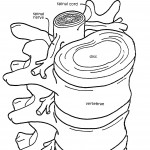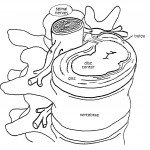Sciatica and Herniated Discs
Not all sciatica is caused by herniated discs.
Not all herniated discs are in the low back.
Not all herniated discs cause pain.
With that said, often low back pain is associated with sciatica and one or more herniated discs.
What is Sciatica?
The sciatic nerve is the only nerve in the body with a name all its own. It runs from the spine at the belt line down the back of the leg to the heel of the foot. It can be irritated and create pain anywhere along its course. What usually irritates the nerve is a misaligned vertebra in what is referred to as a subluxation complex; a cascading series of events that usually starts with a message from your brain that results in a misaligned vertebra, inflammation, muscle spasm, and congestion of waste products creating pressure. Along with the subluxation complex there can be a bulging or a protruded disc.
What are Herniated Discs?

Discs lie between every vertebra. They are made out of the same stuff your ears and the end of your nose is made of- cartilage. Rings of cartilage surround a center of a soft gelatinous material. This whole package is under so much pressure the soft center becomes hard and acts as ball bearing. Discs have living cells in them but no blood vessels to feed them nutrients or take away waste products as most living cells do. They survive by a process called imbibition, this is the pumping action created when the spine moves and vertebrae pull away from each other and close on each other changing pressure and drawing spinal fluid in and out. The spinal fluid contains nutrients. For several reasons including abnormal movement of vertebrae the walls of the disc become weak. As fluid tries to flow in to the disc it becomes much like an above the ground swimming pool with weak sides, instead of filling up the sides bend and bulge out. That is a bulged disc. If the damage continues the rings of cartilage lose their elasticity becoming somewhat brittle and small cracks develop allowing the gelatinous material held within the rings to protrude. That is a herniated disc.

Can Herniated Discs be Repaired?
A chiropractic technique referred to as flexion/distraction changes the pressure in a herniated disc and allows it to take in spinal fluid, feeding the cells and pulling out waste products. This change in pressure within the disc also draws the gelatinous material that has protruded out the cracks in the rings of the disc back to the center where it is supposed to be. I use this technique often to improve disc function. Along with a variety of chiropractic adjusting methods a herniated disc can repair.
A chiropractic adjustment has the ability to change how the brain controls the position of vertebrae and the tone of muscles. I adjust the spine and limbs to send messages to the brain, so the brain will fire back down to the spine and muscles in a different pattern. Stimulation from the spine is very powerful to the brain.
Brain cells should fire in a smooth, fast pattern (much like the cylinders of a car’s engine). Improving the firing pattern of brain cells stabilizes the cell membrane creating a healthier cell. When groups of healthy brain cells fire together they wire together and this increases the speed of brain activity. Increased wiring and increased speed is a good thing. Sometimes my intent is to create excitation or increase the input from brain to body, other times my intent is to create inhibition or a calming of a particular pathway from the brain to the body. When the brain repeatedly receives these types of specific stimulation it makes changes in its wiring that is long lasting. This long lasting rewiring of the brain is called placidity. That is my goal to creating positive long lasting effects for my patients with sciatica, disc problems and back pain.
.
